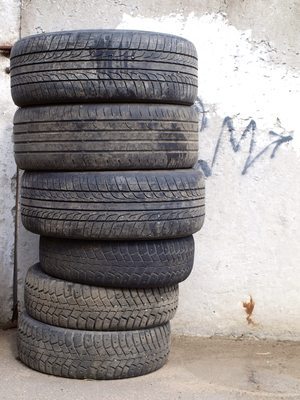 by Garrett Schwartz
by Garrett Schwartz
Have you checked your tires lately? Despite being an essential part of every vehicle, they are often neglected. Like most wear-and-tear items on your vehicle, your tires become increasingly vulnerable to damage and failure as they age. Old, worn tires represent a clear danger for drivers, so it’s important to know when to replace them.
A Tire’s Life
The average lifespan of a car tire varies depending on a variety of factors, from average road conditions and mileage driven to outdoor climate, compound choice and driver upkeep. For example, underinflation can significantly reduce the working lifespan of the average tire. A National Highway Traffic Safety Administration (NHTSA) report found that vehicles driving on tires underinflated by 25 percent are three times more likely to be involved in a tire-related crash.
Most manufacturers recommend tire replacement at least every six years, although some manufacturers recommend intervals as long as 10. To check the age of your tire, simply locate the last three or four-digits of the Department of Transportation identification number located on the sidewall (i.e. “DOT U2LL LMLR 5107”). For example, “51” indicates manufacture during the 51st week of the year and “07” indicates manufacture during 2007.
Warning Signs
It’s important to spot the warning signs of a tire that’s well past its prime:
- Dry rot – As a tire ages, the oils and chemicals within the rubber compound evaporate or break down with constant exposure to ultraviolet light. The rubber becomes brittle, making it more likely for cracks to form along the sidewall and other flexible portions of the tire. In some cases, the tread may even begin to separate from the tire.
- Vibrations and noise – That thumping sound or vibration through your steering wheel might feel like the suspension acting up, but it could be the sign of a badly worn tire or a tire with a separated radial belt.
- Thin tread – The NHTSA found that nine percent of vehicles on U.S. roadways are driven with at least one bald tire. In most states, tires are legally worn out when the remaining tread thickness reaches 2/32 of an inch. Many tires have wear bars incorporated into their design to alert drivers when their tires require replacement. The best way to measure tire tread is with a depth gauge, although you can place a penny into the tread groove, too. The general rule is if you see Lincoln’s head, you have less than 2/32 of an inch of tread left.
Shopping for New Tires
With a wide variety of tire choices, finding the right tire seems like a daunting task. Reputable sites like TireBuyer.com can help you find the proper tire for your vehicle, as well as offer critical information about wear and proper care.
Preventative maintenance such as wheel balancing and wheel alignments can help extend the life of a tire. According to AAA, you should have your tires rotated and balanced every 6,000 miles and wheels aligned every 12,000 miles. Keep your tires properly inflated as specified in your vehicle owner’s manual to also help extend their working life.
About The Author
Garrett Schwartz
Garrett can be found in his garage working on his ’69 Mustang and blogging about cars past to present.
Leave a Reply
You must be logged in to post a comment.